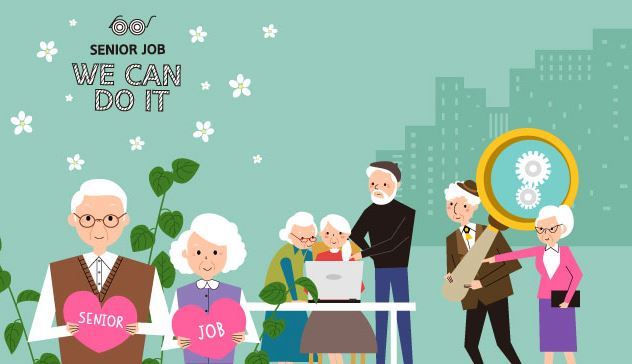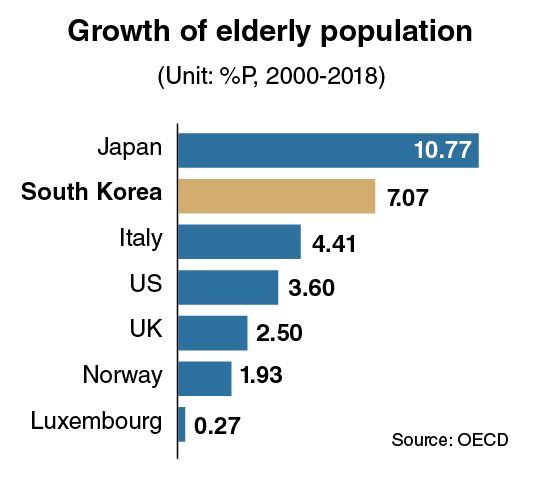[News Focus] South Korea aging 2nd-fastest in OECD since 2000
By Kim Yon-sePublished : Sept. 20, 2020 - 14:17

SEJONG -- South Korea ranked 2nd in the growth of its senior population since 2000 among the 37 members of the Organization for Economic Cooperation and Development, though the nation was still only 30th in terms of the current senior population.
According to the OECD, Korea saw the portion of seniors -- aged 65 or over -- of the entire population at 7.22 percent in 2000. But the figure climbed by 7.07 percentage points in less than two decades to 14.29 percent as of 2018.
This marked the second-steepest rise, after Japan, which posted a 10.77 percentage point growth over the corresponding period.
The figure for Korea far exceeded the OECD average (by 4.12 percentage points) and the world average (by 2.03 percentage points).
While Finland ranked 3rd with a 6.69 percentage point growth, there was no other OECD member whose growth exceeded the 6 percent mark.
Among those lagging behind the OECD average were France with 3.97 percentage points, Switzerland with 3.05 percentage points, and the US with 3.6 percentage points.

In terms of the portion of the population aged over-65, South Korea was still behind the OECD average of 17.2 percent in 2018.
Japan topped the list at 28.14 percent, followed by Italy at 22.68 percent, Greece at 21.89 percent, Portugal at 21.67 percent, Finland at 21.61 percent, Germany at 21.47 percent and Latvia at 20.18 percent.
Nevertheless, Korea is expected to outstrip the average in one or two years and overtake many countries in the coming decade.
As of August 2020, the nation saw the percentage of seniors reach an all-time high of 16.1 percent -- 8.35 million of the entire population, 51.83 million, according to the Ministry of Interior and Safety. This indicates that nearly 1 out of every 6 Koreans were aged 65 and above.
Data held by Statistics Korea showed that the senior population is projected to make up 20.3 percent in 2025, 25 percent in 2030, 30.5 percent in 2036, 40.2 percent in 2051 and 45.4 percent in 2067.
Apart from the world’s lowest fertility rates, global comparison data has showed that Koreans’ lifespan is expanding fast, particularly for women.
Korea ranked 3rd in women’s life expectancy at birth among the 37 OECD members in its 2018 comparison.
The OECD defined the life expectancy at birth as how long, on average, a newborn can expect to live if current death rates do not change. Korean female newborns are projected to live 85.7 years on average.
The figure is quite high compared to 81.1 years for girls in the US, 80.8 years in Turkey and 79.3 percent in Hungary.
In fact, only Japanese girls (87.3) and Spanish girls (86.1) had higher life expectancies than Korean girls born in the late 2010s.
Statistics Korea estimates that the life expectancy for Koreans born in 2020 would reach 83.2 years -- 80.3 for men and 86.1 for women -- rising to 84.2 for those born in 2025.
After topping 85 in 2029, the figure would gradually climb to 86.8 in 2040, 88.2 in 2050, and 90 -- 88.4 for men and 91.6 for women -- in 2066, the state-funded agency predicted.
By Kim Yon-se (kys@heraldcorp.com)








![[KH Explains] How should Korea adjust its trade defenses against Chinese EVs?](http://res.heraldm.com/phpwas/restmb_idxmake.php?idx=644&simg=/content/image/2024/04/15/20240415050562_0.jpg&u=20240415144419)










![[Today’s K-pop] Stray Kids to return soon: report](http://res.heraldm.com/phpwas/restmb_idxmake.php?idx=642&simg=/content/image/2024/04/16/20240416050713_0.jpg&u=)